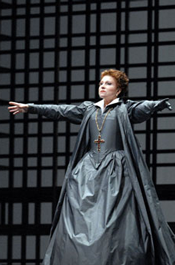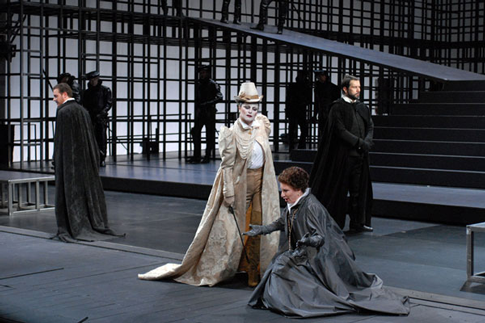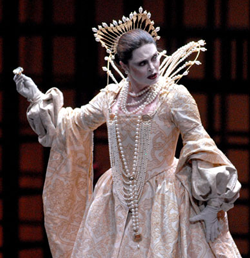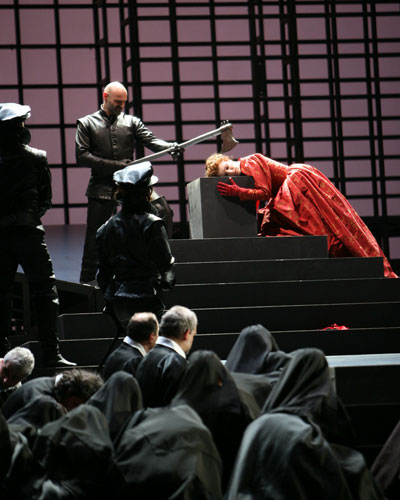
28 Jan 2008
Two Queens in Full Cry
What constitutes an “international opera star” these days, anyway?
English Touring Opera are delighted to announce a season of lyric monodramas to tour nationally from October to December. The season features music for solo singer and piano by Argento, Britten, Tippett and Shostakovich with a bold and inventive approach to making opera during social distancing.
This tenth of ten Live from London concerts was in fact a recorded live performance from California. It was no less enjoyable for that, and it was also uplifting to learn that this wasn’t in fact the ‘last’ LfL event that we will be able to enjoy, courtesy of VOCES8 and their fellow vocal ensembles (more below …).
Ever since Wigmore Hall announced their superb series of autumn concerts, all streamed live and available free of charge, I’d been looking forward to this song recital by Ian Bostridge and Imogen Cooper.
Although Stile Antico’s programme article for their Live from London recital introduced their selection from the many treasures of the English Renaissance in the context of the theological debates and upheavals of the Tudor and Elizabethan years, their performance was more evocative of private chamber music than of public liturgy.
Evidently, face masks don’t stifle appreciative “Bravo!”s. And, reducing audience numbers doesn’t lower the volume of such acclamations. For, the audience at Wigmore Hall gave soprano Elizabeth Llewellyn and pianist Simon Lepper a greatly deserved warm reception and hearty response following this lunchtime recital of late-Romantic song.
For this week’s Live from London vocal recital we moved from the home of VOCES8, St Anne and St Agnes in the City of London, to Kings Place, where The Sixteen - who have been associate artists at the venue for some time - presented a programme of music and words bound together by the theme of ‘reflection’.
'Such is your divine Disposation that both you excellently understand, and royally entertaine the Exercise of Musicke.’
‘And there was war in heaven: Michael and his angels fought against the dragon; and the dragon fought and his angels, And prevailed not; neither was their place found any more in heaven … that old serpent … Satan, which deceiveth the whole world: he was cast out into the earth, and his angels were cast out with him.’
There was never any doubt that the fifth of the twelve Met Stars Live in Concert broadcasts was going to be a palpably intense and vivid event, as well as a musically stunning and theatrically enervating experience.
‘Love’ was the theme for this Live from London performance by Apollo5. Given the complexity and diversity of that human emotion, and Apollo5’s reputation for versatility and diverse repertoire, ranging from Renaissance choral music to jazz, from contemporary classical works to popular song, it was no surprise that their programme spanned 500 years and several musical styles.
The Academy of St Martin in the Fields have titled their autumn series of eight concerts - which are taking place at 5pm and 7.30pm on two Saturdays each month at their home venue in Trafalgar Square, and being filmed for streaming the following Thursday - ‘re:connect’.
The London Symphony Orchestra opened their Autumn 2020 season with a homage to Oliver Knussen, who died at the age of 66 in July 2018. The programme traced a national musical lineage through the twentieth century, from Britten to Knussen, on to Mark-Anthony Turnage, and entwining the LSO and Rattle too.
With the Live from London digital vocal festival entering the second half of the series, the festival’s host, VOCES8, returned to their home at St Annes and St Agnes in the City of London to present a sequence of ‘Choral Dances’ - vocal music inspired by dance, embracing diverse genres from the Renaissance madrigal to swing jazz.
Just a few unison string wriggles from the opening of Mozart’s overture to Le nozze di Figaro are enough to make any opera-lover perch on the edge of their seat, in excited anticipation of the drama in music to come, so there could be no other curtain-raiser for this Gala Concert at the Royal Opera House, the latest instalment from ‘their House’ to ‘our houses’.
"Before the ending of the day, creator of all things, we pray that, with your accustomed mercy, you may watch over us."
The doors at The Metropolitan Opera will not open to live audiences until 2021 at the earliest, and the likelihood of normal operatic life resuming in cities around the world looks but a distant dream at present. But, while we may not be invited from our homes into the opera house for some time yet, with its free daily screenings of past productions and its pay-per-view Met Stars Live in Concert series, the Met continues to bring opera into our homes.
Music-making at this year’s Grange Festival Opera may have fallen silent in June and July, but the country house and extensive grounds of The Grange provided an ideal setting for a weekend of twelve specially conceived ‘promenade’ performances encompassing music and dance.
There’s a “slide of harmony” and “all the bones leave your body at that moment and you collapse to the floor, it’s so extraordinary.”
“Music for a while, shall all your cares beguile.”
The hum of bees rising from myriad scented blooms; gentle strains of birdsong; the cheerful chatter of picnickers beside a still lake; decorous thwacks of leather on willow; song and music floating through the warm evening air.

What constitutes an “international opera star” these days, anyway?
Mariella Devia may not be the flavor-of-the-month in “au courant” operatic circles; she may not be giving come-hither looks in the current round of air-brushed Rolex ads; nor may recording companies be promoting her in hyper-drive as the next “diva du jour” (read: meal ticket).
Nevertheless, in La Scala’s new and highly effective “Maria Stuarda,” Signora Devia scored her considerable artistic triumph the old-fashioned way, free of hype and extra-musical baggage, by simply showing up and singing the living hell out of the titular queen, like any truly great star surely should.
I first heard this wonderful artist. . .well, a number of years ago, and I remembered hers to be a full, flexible, accomplished lyric voice with good thrust. Not a fussy, artsy interpreter, she made fine effect with heartfelt, well-studied vocalizing, sound technique, and simplicity of gesture. The good news is that, lo, these many years later, although time has darkened the instrument a bit, this accomplished soprano is still singing superlatively well. And she still looks petite and lovely, to boot.
Ms. Devia has all the requisite assets at her command to make a most persuasive case for our heroine. She negotiates even the trickiest coloratura with skill and accuracy, and imbues it with dramatic meaning. She scores every single time with spot-on, thrilling notes “in alt.” Indeed at opera’s end, she sang what seemed like a “q” above high “z” sounding as fresh as at the start, beginning the note at moderate volume and swelling to a full-bodied forte. Throughout, she displayed masterful use of portamento, crafting arching lines which were often achingly beautiful. And she called forth some steel in her tone and starch in her demeanor as needed to drive the drama forward in her important confrontational declamations.
If this seasoned soprano seems to employ a few small “tricks” these days, like slightly veiling soft high notes that are approached with a leap rather than a scale progression, and pacing her volume here and there to conserve her full arsenal for the “money” sections, it is very minor quibbling. Mariella Devia has all of the goods (and some to spare) to successfully take on this demanding role and make a notable star turn out of it. The Milanese public rewarded her with a deafening appreciation at final curtain.
 Mariella Devia, Anna Caterina Antonacci, Francesco Meli, Carlo Cigni (Act I)
Mariella Devia, Anna Caterina Antonacci, Francesco Meli, Carlo Cigni (Act I)
Happily, we were just as lucky with our other queen, in the guise of Anna Caterina Antonacci’s “Elisabetta.” The tall, lanky, and beautiful Ms. Antonacci was every bit her rival’s equal, proving to be a perfect foil physically and musically. For ACA has a rangy, disciplined, highly individual, and powerful voice, with a fair measure of metal -- and a big measure of mettle -- driven by technical mastery. This “seconda donna” also scored big with the vociferously appreciative crowd for her imposing glamorous star presence as much as for an imperious outpouring of focused sound.
The program book referred to a past successful (1971) Scala production of “Maria Stuarda” with the established stars Shirley Verrett and Montserrat Cabelle. It couldn’t help but provoke my comparing “what was” to “what is” and I have to say that Mesdames Devia and Antonacci seemed to more than hold their own up against such a previous fabled pairing. Blessed is the house that can find two complementary divas of such stature, not once, but now twice in its recent history. Bravi.
The scheduled tenor Francesco Meli was indisposed, so “Leicester” was capably assumed by Dario Schmunck. Mr. Schmunck is currently singing such things as “Elvino,” “Alfredo, “ and “Leicester” around European houses, and was already scheduled for it at La Scala later in the run. He is possessed of a perfectly pleasant lyric voice which he uses intelligently.
In a major house as this, I thought he would be, say, a perfect “Cassio,” but “Leicester” is decidedly a much bigger “sing,” calling for leading man star quality and panache that he does not yet quite fully possess.
His first aria was greeted with a derogatory comment (shouted by one of the claquers?), and he certainly did not deserve that. His enjoyable performance does still seem a work in progress, and while unfailingly pleasant and well-sung, Schmunck was not quite on a level of fire power with our two queens, from whom he notably took considerable inspiration in each of the separate duets.
Piero Terranova’s “Cecil” began somewhat tentatively. Indeed in Act One, his important solo rants were curiously weak-voiced and covered by the orchestra. Thankfully, he progressively found his stride, and by Act Three he was offering compelling, full-throated singing. “Cecil” may be a comparatively small role, but he fuels so much of the conflict that it was welcome for Terranova to come to the party in due course.
Carlo Cigni brought beauty and amplitude of tone, fine vocal presence, and sincere acting to “Talbot.” In the minor role of “Anna,” Paola Gardina displayed an uncommonly beautiful voice, one not usually lavished on such a small part. I look forward to encountering both Cigni and Gardina in future performances and larger assignments. The exemplary choral work was prepared by Bruno Casoni.
Musical values were of a very high standard. Maestro Antonio Fogliani led the excellent resident orchestra in a taut, largely unsentimental reading, that still allowed for breadth of utterance as well as touching, highly introspective musings such as in the famous Act III prayer. Especially in the sextet and the larger choral moments, Fogliani commanded admirably clean control of his assembled forces to exciting musical effect.
The venerable Pier Luigi Pizzi did his usual triple duty as set designer, costume designer, and director. The costumes were sumptuous, character-specific, evocative if not slavishly “period-correct,” and meaningful. His Elizabeth-as-Fashionista “take” worked well, and Antonacci seemed to revel in her spiffy duds. Mary’s silvery-black frock may have had the required austerity but it was elegantly handsome; and topping all else in the show, her spectacular red dress for the final prayer and execution (forgive me) was to die for.
The handsome, functional set was framed within a sort of “box” of industrial scaffolding that suggested a prison. Centered within it were gradated stepped platforms, shaped rather like an Incan pyramid, the top level of which was joined to perimeter walkways by three symmetrical ramps. By using different lighting washes on the cyclorama, many evocative silhouettes could be created. However, Mr. Pizzi’s floor plan did tend to restrict traffic patterns to a certain sameness of movement for the larger scenes.
Pizzi created a truly brilliant effect for the garden, in which we first encounter Queen Mary. The “pyramid” having been surreptitiously retracted, a full grove of life-like trees rises from underneath the stage like a veritable “dawn” of greenery, including an astro-turfed “bank” on which Mary can luxuriate and stroll. Other than this beautifully calculated forest, the overall unit setting was not intended to communicate a literal sense of time or place, but it was very pleasing to look at and functional.
 Anna Caterina Antonacci (Elisabetta)
Anna Caterina Antonacci (Elisabetta)
The prison metaphor not only worked for the obvious enclosure of Mary, but suggested that “Elisabetta” was perhaps in her own “prison,” being constrained by the royal behavior and sometimes unpleasant duties expected of rulers. Part of the design concept was creating a sort of “living sculpture,” peopling this setting with omnipresent guards who prowled the structure brandishing torches. This leather clad, eye candy ensemble of strapping young men may not have added all that much, but neither did it unduly distract.
The high accomplishments of Pizzi the designer were not quite matched by Pizzi the director. I am grateful indeed that there was no bizarre “concept” imposed, that the groupings and stage placement were always serviceable and the movement cleanly competent, all of which told the story and allowed the artists to sing their best. And, yes, that famously bitchy duet scene between the two queens certainly made its full mark, and there were some lovely personalized touches overall.
Still, I had the feeling that there was more to be mined dramatically out of two such wonderful sopranos, especially the always creative Ms. Antonacci, whose “Elisabetta” seemed to settle for two-dimensions when my experience with her in past performances has shown she is fully capable of three (or more).
The one concession to modest “innovation” was that during the opening bars of the first scene, a pantomime was created in which our heroine is given communion by “Talbot,” effectively establishing her faith-based credentials and defining her predicament. (Although, since she later unceremoniously and rousingly calls her cousin a “vile bastard,” I was thinking: “And you take communion with that mouth, Miss Mary?”)
It has been said that acting is really listening. . .and re-acting. And here I think lay a (fixable) minor shortcoming of the production. Characters aren’t consistently listening to each other. And reacting. The above mentioned epithet may be the most glaring (but not only) example, for after “Maria” hurled “Vil bastarda!” at “Elisabetta,” there was scant-to-no-reaction, with “Anna” actually just remaining complacently seated. I mean, the take-no-prisoners Queen has just been insulted (all right, all right, she has taken one or there would be no story)! I would hope that some minor tweaking and enhanced character interplay could be instilled that could make an already fine evening even finer.
In past years, much ink has been spilled and hands wrung about the state of the art at La Scala. At least based on this visit, its reputation as one of the world’s leading opera houses has emphatically been sustained. A tour of their adjacent museum was revelatory as to how this lofty regard came to be established in the first place, since it contains numerous terrific portraits, photos, mementos, props, scores, letters, and instruments touched by many (perhaps most) of the greatest composers and interpreters of the last 200 years of operatic history, all of whom gifted their musical talents to La Scala.
 Scene from Act II
Scene from Act II
It is also telling that, currently on view, there is a special display of costumes worn by Maria Callas for all the roles she performed at the house. This remembrance of the thirtieth anniversary of her death offered a reminder, should any be needed, that we would not perhaps be hearing “Maria Stuarda” and a good deal of the bel canto repertoire in wide performance today were it not for La Divina’s blinding talent and trail-blazing musical advocacy.
Maria may be gone but it seems La Scala can still summon up greatness, as Mariella Devia and company aptly demonstrated. The Queen is dead. Long live the Queen.
James Sohre